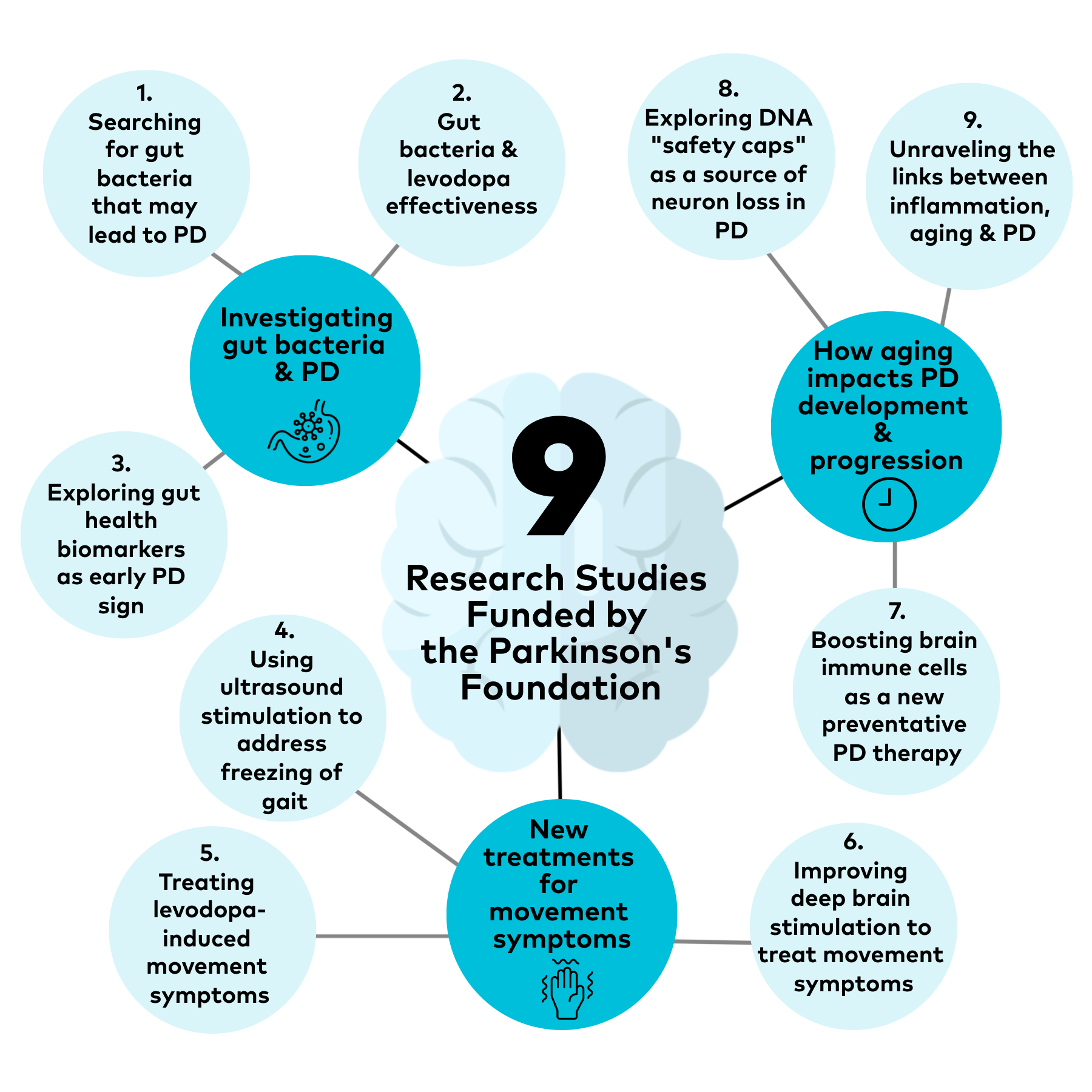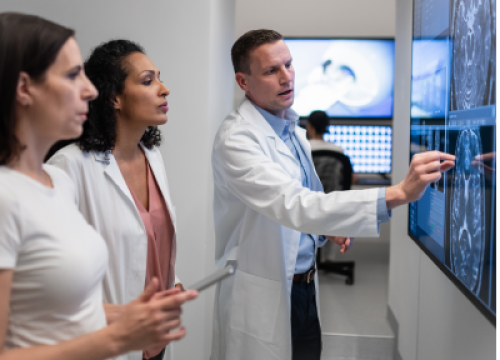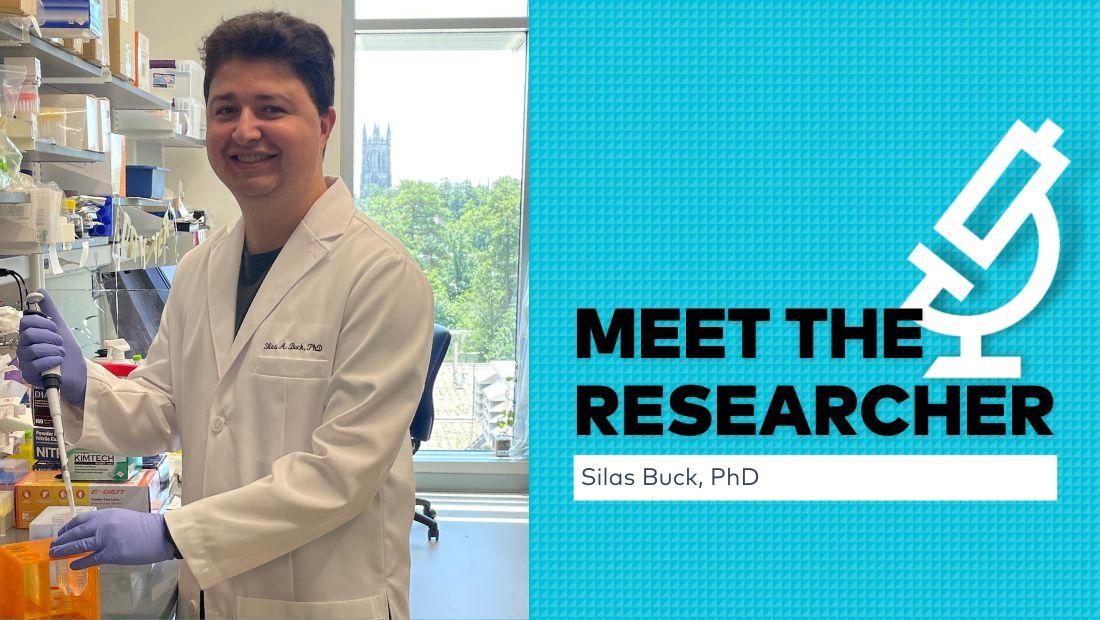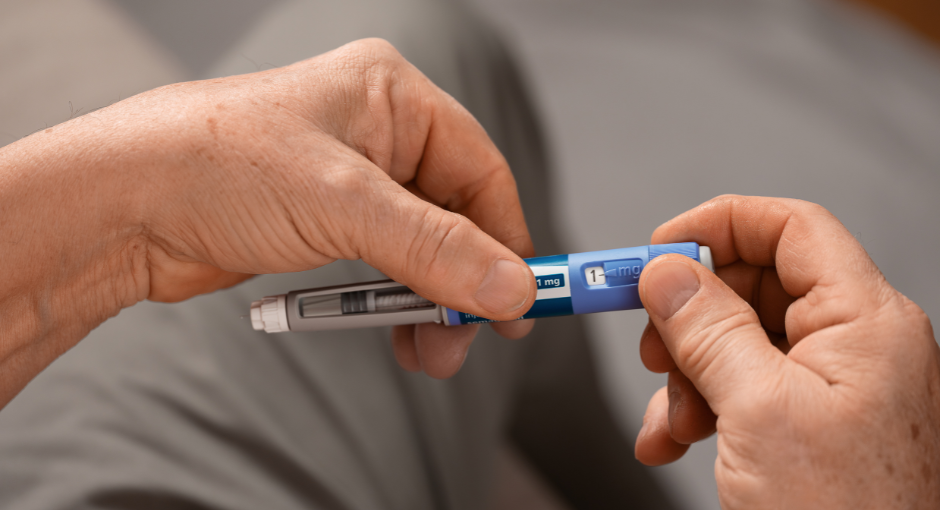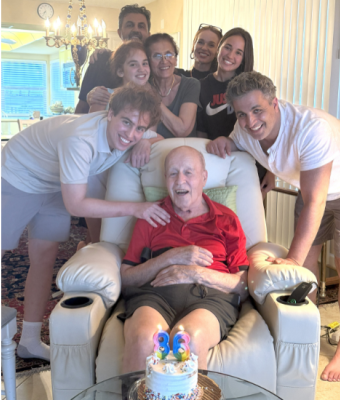Ganando terreno: La búsqueda por mejorar e introducir nuevos medicamentos contra el Parkinson

El bioquímico Kevin McFarthing recuerda todo acerca de su diagnóstico de la enfermedad de Parkinson (EP). "Me lo diagnosticaron a las 4 p.m. del 10 de diciembre de 2012", dijo. Desde entonces, ha estado tras la pista de una cura, catalogando potenciales terapias contra el Parkinson como coeditor de Clinical Trial Highlights, Journal of Parkinson's y organizando a lista Parkinson's Hope List, una base de datos de más de 350 estudios en curso.
En Expert Briefings-Charlas con expertos: Los últimos avances en la investigación y el tratamiento del Parkinson, el Dr. McFarthing comparte los últimos avances en la investigación y de qué manera el participar en estudios clínicos nos acerca a una cura.
La urgencia por avanzar
El Parkinson va en aumento. Un estudio apoyado por la Parkinson's Foundation reveló que 90,000 personas en los EE.UU. son diagnosticadas con la enfermedad cada año. Para 2040, más de 12 millones de personas en todo el mundo vivirán con la EP. Las compañías farmacéuticas están interesadas en acelerar una cura. La identificación de nuevas terapias contra el Parkinson es una de las principales prioridades de la investigación y el desarrollo farmacéuticos.
"Todos tenemos nuestra propia visión de lo que podría significar la cura", dijo el Dr. McFarthing. Para algunos, podría ser "una solución mágica para resolver los síntomas y devolver nuestras capacidades a como éramos antes". Otros podrían esperar "un fármaco que brinde otros 10 años de vida sin síntomas".
Los desafíos
Aunque las compañías farmacéuticas están buscando terapias avanzadas para el Parkinson, los costos son elevados y la competencia por la financiación es fuerte. Innumerables medicamentos de prueba fracasan a menudo en el camino hacia un fármaco de éxito para el sistema nervioso central, como la levodopa (la actual terapia de primera línea contra el Parkinson, descubierta hace más de 50 años).
Según el Centro Tufts para el Estudio del Desarrollo de Medicamentos, una terapia para el sistema nervioso central puede costar más de $2 mil millones en investigación y tardar casi un 20% más que otros fármacos en desarrollarse.
El Parkinson es complejo. Los síntomas se manifiestan de forma diferente en cada persona, lo que dificulta un enfoque único para el tratamiento farmacológico. La participación en la investigación es esencial para descubrir las causas de la enfermedad y encontrar nuevos tratamientos para los síntomas que la gente ve —incluyendo el temblor, la rigidez y la lentitud de movimientos— y los diversos no motores que acompañan a la EP.
Investigaciones diversas y la inversión continua también son esenciales. Por suerte, como señala el Dr. McFarthing, "se está realizando mucho trabajo".
En todo el mundo hay más de 100 estudios que exploran formas de mejorar diversos síntomas de la EP. Más de 250 estudios están investigando posibles terapias modificadoras de la enfermedad, tratamientos que podrían ralentizar, detener o invertir el avance de la enfermedad.
Sacando nuevos tratamientos a la luz
Tras identificar un nuevo tratamiento prometedor para una enfermedad mediante estudios observacionales, animales o celulares, los investigadores buscan financiación y participantes para ensayos clínicos. Estos ensayos, cuidadosamente supervisados, se realizan por fases, —normalmente probando un agente activo frente a un placebo—, para determinar su seguridad y eficacia. Por lo general, una terapia prospectiva debe superar con éxito las fases 1, 2 y 3 antes de que la Administración de Alimentos y Medicamentos de los EE.UU. (Food and Drug Administration o FDA, por sus siglas en inglés) decida si una empresa puede presentar una solicitud de nuevo fármaco.
Algunos de los estudios de tratamiento a tener en cuenta son:
Terapias para la discinesia (movimientos involuntarios, erráticos y retorcidos), dirigidas a los efectos secundarios asociados al uso prolongado de la levodopa:
-
Celon Pharma S.A. obtuvo resultados positivos de fase 2 con su CPL'36 oral, de una sola toma al día. El fármaco dificulta la actividad de la enzima fosfodiesterasa 10a, aumentando los niveles cerebrales de ciertos mensajeros químicos para mejorar el control motor.
-
Tras finalizar los ensayos de fase 2B, el mesdopetam (IRL790) de IRLAB no alcanzó los criterios de valoración primarios. Los investigadores siguen evaluando su potencial terapéutico. El fármaco bloquea la actividad del receptor D3 de la dopamina, que puede estar relacionado con la discinesia inducida por la levodopa.
-
La fase 1 de investigación del AV-101 de Vistagen está en curso. El fármaco actúa sobre los receptores de N-metil-D-aspartato (NMDA) que tienen fallas. Unos receptores sanos son fundamentales para la comunicación entre las células nerviosas del cerebro.
-
Se espera que Sinopia Biosciences inicie los ensayos clínicos de un candidato preclínico a fármaco contra la discinesia: el SB-0110.
Este fármaco maximiza el tiempo en “on”, el periodo en que la levodopa proporciona el máximo control de los síntomas. A medida que progresa el Parkinson, la persona puede experimentar más tiempos en “off". Las terapias destinadas a prolongar el tiempo en "on" incluyen:
-
Vyalev (Produodopa en Europa), disponible en los EE.UU. desde 2024. Esta nueva formulación de levodopa está dirigida al Parkinson avanzado. Una bomba portátil administra una infusión constante de medicamento bajo la piel, proporcionando un control más constante de los síntomas. Vyalev también puede mejorar la calidad del sueño, los tiempos en "off" a primera hora de la mañana y otros síntomas.
-
Tavapadon estimula determinados receptores de dopamina para mejorar la función motora y reducir los efectos secundarios. Los agonistas dopaminérgicos actuales no son selectivos y los efectos secundarios pueden incluir comportamientos compulsivos y alucinaciones visuales. Tavapadon proporcionó un buen control de los síntomas en los ensayos de fase 3 como medicación independiente y cuando se utilizó junto con la levodopa. El fabricante, AbbVie, tiene previsto presentar este año una solicitud de nuevo fármaco a la FDA.
La investigación con células madre es un desafío. Implica cirugía cerebral y, tras la implantación de células, se necesita tiempo para ver si los síntomas mejoran. A pesar de los numerosos estudios con células madre para el Parkinson, los investigadores no habían pasado de la fase 2 hasta hace poco:
-
BlueRock Therapeutics, una división de Bayer, presentó datos positivos de fase 1 sobre bemdaneprocel, una terapia celular que busca sustituir las neuronas productoras de dopamina que se pierden a causa del Parkinson. Con base en estos datos, la FDA concedió al fármaco la designación de terapia avanzada de medicina regenerativa, permitiéndole pasar a los ensayos de fase 3 a principios de 2025.
Algunas de las terapias en investigación prometedoras para detener o frenar la progresión de la EP son:
-
Factores de crecimiento neurotróficos, moléculas que estimulan el crecimiento de los nervios. Estos podrían beneficiar a las personas con Parkinson. El AB-1005 de AskBio, un factor neurotrófico derivado de una línea celular glial (GDNF, por sus siglas en inglés) administrado directamente al cerebro, puede minimizar la pérdida de dopamina asociada al Parkinson.
-
Beneficios neuroprotectores potenciales del factor neurotrófico derivado del cerebro y del factor neurotrófico dopaminérgico cerebral.
-
Los inhibidores de la proteína inflamasona NLRP3 pretenden bloquear la activación de moléculas inflamatorias relacionadas con la pérdida de dopamina en el Parkinson.
-
Posibles beneficios neuroprotectores de la nicotinamida ribósida, una forma de la vitamina B3.
Los investigadores también están explorando formas de prevenir la acumulación de la proteína alfa-sinucleína, la proteína que forma cúmulos tóxicos, llamados cuerpos de Lewy, en el cerebro de las personas con la EP:
-
Los estudiso de fase 2 de prasinezumab de Roche, dirigidos a la acumulación y propagación de la alfa-sinucleína. El estudio no alcanzó su objetivo, pero la compañía planea buscar datos que potencialmente muestren beneficios del prasinezumab en el Parkinson inicial.
-
Annovis Bio Fase 3 concluyó recientemente los estudios sobre buntanetap, un fármaco que reduce la producción de alfa-sinucleína. Buntanetap no alcanzó los objetivos del estudio. No obstante, la empresa tiene previsto seguir investigando el fármaco.
-
Las mutaciones en el gen GBA (que produce la enzima glucocerebrosidasa, o Gcase) son uno de los más frecuentes factores genética de riesgo de la EP. Varias empresas están investigando si los compuestos que estimulan la actividad Gcase pueden mejorar la función motora u ofrecer neuroprotección.
-
Se ha demostrado que el Ambroxyl, un medicamento para la tos utilizado para reducir la flema, aumenta la actividad de la Gcase en personas con Parkinson. Puede eliminar los cúmulos tóxicos de alfa-sinucleína. Está en marcha un ensayo de fase 3.
-
-
Las mutaciones del gen LRRK2 son la causa más frecuente de la EP genética. Estudios de investigación en cuatro empresas están explorando cómo los inhibidores de la LRRK2 podrían aportar beneficios neuroprotectores. Otras cinco empresas están en fase de ensayos clínicos.
Otras posibles terapias modificadoras de la enfermedad son los agonistas del GLP-1. Principalmente desarrollados para controlar la diabetes, los agonistas del GLP-1 imitan la hormona humana péptido-1, similar al glucagón (GLP-1), que controla el azúcar en sangre y el apetito. Algunos delos estudios recientes sobre agonistas del GLP-1 son:
-
Terapia con lixisenatida. Los participantes con la EP inicial en el ensayo de fase 2 experimentaron una menor progresión de la discapacidad motora que el placebo a los 12 meses. Sin embargo, muchos participantes experimentaron efectos secundarios gastrointestinales.
-
La liraglutida mostró una mejoría significativa en algunos síntomas no motores, pero ninguna diferencia en los síntomas motores durante el estudio de fase 2.
-
La investigación de fase 3 sobre la exenatida demostró que el fármaco era seguro y bien tolerado, pero no mostró ninguna ventaja sobre el placebo en el Parkinson.
-
Las investigaciones de fase 2 de NLY01, exenatida modificada, no mostraron mejorías en los síntomas del Parkinson.
-
Los investigadores están a la espera de los resultados de un estudio clínico de fase 2 del Hospital Universitario de Oslo que explora el valor potencial de la semaglutida en el Parkinson.
Construir sobre la esperanza
La única manera de acelerar el desarrollo de tratamientos que puedan ralentizar o detener el Parkinson es a través de una financiación amplificada y continua. El Fondo de Biotecnología Virtual para el Parkinson (Parkinson's Virtual Biotech) , una asociación entre la Parkinson's Foundation y Parkinson's UK, financia 11 nuevos medicamentos y terapias bajo investigación y desarrollo.
La iniciativa Edmond J. Safra Accelerating Clinical Treatments for Parkinson's Disease (EJS-ACT PD, por sus siglas en inglés) tiene como objetivo acelerar las terapias de prueba de fármacos seguros utilizando diseños de ensayos multibrazo y multietapa (MAMS, por sus siglas en inglés), un enfoque más novedoso y rentable.
Los ensayos MAMS permiten a los investigadores evaluar varios tratamientos a la vez contra un placebo. Los investigadores pueden descubrir lo que funciona y descartar lo que no, sin tener que desmontar un ensayo y empezar de nuevo. El objetivo es facilitar una transición fluida y rentable a la siguiente fase de los ensayos y comercializar más rápidamente nuevas terapias eficaces. Hay otros ensayos MAMS para Parkinson en marcha en todo el mundo.
"Esperamos tener más fracasos que éxitos debido a la naturaleza de lo que intentamos hacer", dijo McFarthing. "Pero creemos que algo resultará de esto".
Cómo participar en la investigación sobre el Parkinson:




